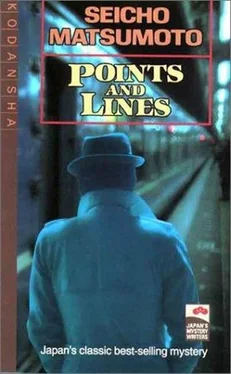Seichō Matsumoto - Points And Lines
Здесь есть возможность читать онлайн «Seichō Matsumoto - Points And Lines» весь текст электронной книги совершенно бесплатно (целиком полную версию без сокращений). В некоторых случаях можно слушать аудио, скачать через торрент в формате fb2 и присутствует краткое содержание. Жанр: Детектив, на английском языке. Описание произведения, (предисловие) а так же отзывы посетителей доступны на портале библиотеки ЛибКат.
- Название:Points And Lines
- Автор:
- Жанр:
- Год:неизвестен
- ISBN:нет данных
- Рейтинг книги:5 / 5. Голосов: 1
-
Избранное:Добавить в избранное
- Отзывы:
-
Ваша оценка:
- 100
- 1
- 2
- 3
- 4
- 5
Points And Lines: краткое содержание, описание и аннотация
Предлагаем к чтению аннотацию, описание, краткое содержание или предисловие (зависит от того, что написал сам автор книги «Points And Lines»). Если вы не нашли необходимую информацию о книге — напишите в комментариях, мы постараемся отыскать её.
Points And Lines — читать онлайн бесплатно полную книгу (весь текст) целиком
Ниже представлен текст книги, разбитый по страницам. Система сохранения места последней прочитанной страницы, позволяет с удобством читать онлайн бесплатно книгу «Points And Lines», без необходимости каждый раз заново искать на чём Вы остановились. Поставьте закладку, и сможете в любой момент перейти на страницу, на которой закончили чтение.
Интервал:
Закладка:
It was on one of the days when I was feeling desperate that I happened to enter a coffee shop. I like coffee. My boss often makes fun of this, but I was deeply depressed and I wanted to get away from the office. Usually, I go to my favorite shop in Yūraku-chō, but it was raining that day so I stopped in at an unfamiliar place near Hibiya Park.
The shop had a second floor. As I was about to open the front door a young girl approached from the side and we almost collided. She was quite lovely. She was wearing a bright-colored raincoat. I was polite and let her enter first. She smiled at me, went in, and gave her umbrella to the waitress standing near the stairs. I followed and handed over my umbrella also. The waitress, taking us for a couple, quickly tied the two umbrellas together and offered me the check. The girl flushed slightly and I hastened to explain. "No, not together; we're strangers." The waitress apologized, untied the umbrellas and gave us separate checks.
You may think I relate the incident because it flattered me to be taken for the companion of an attractive young girl. Actually, something very different flashed through my mind at the time, something that astounded me. I went upstairs, sat down at one of the tables and for a while didn't even notice the cup of coffee in front of me, which I must have ordered.
The waitress had greeted us as a couple because we happened to enter the shop together. That was natural; almost anyone would have thought so. She drew this hasty inference from the way we had come in the door together. For me, however, the incident started a whole new train of thought.
We-including yourself and the men at your station-had concluded it was a double suicide because Sayama and Otoki were found dead, side by side. Now I understood! They had died separately and at different places. Only after they were dead were the two bodies brought together. Someone gave Sayama the cyanide and he died, and someone gave Otoki the same poison and she died; only then were the two bodies brought to the beach and placed side by side. The two deaths should never have been connected. Since they were similar, we believed it was a single case, but we were wrong.
Don't chide us for immediately concluding it was a case of double suicide when we discovered a man and a woman dead, almost in each other's arms. Love suicides are not uncommon; this is the way the bodies are always found. No one would think of doubting it. And when termed a love suicide, the inquest is never as strict as in the case of a murder. The investigation is generally perfunctory. Tatsuo Yasuda knew this.
I remember something you wrote to me once in a letter: "Sometimes a preconceived opinion will make us overlook the obvious. This is a frightening thing. We call it common sense but it often leaves us with a blind spot." Here was a case in point. A man and a woman are found dead side by side. It is all quite clear. The obvious assumption that it is a love suicide puts an end to any further investigation of the case. And so everyone is deceived. A clever murderer knows this; he will take advantage of this so-called common sense.
This time, the criminal fooled us completely. But he still had reason to feel uneasy. Sayama and Otoki were only slightly connected yet he had to make the double suicide look convincing, he had to give the impression that they were lovers. This is the reason for having the waitresses of the Koyuki witness their departure together from Tokyo Station. He arranged the scene carefully. Nevertheless, a criminal never ceases to worry. In this case, he planned exceptionally well: he used the four-minute interval.
As I look back on it, I see the case built around train and plane schedules, from start to finish. It is buried in timetables. Did Yasuda have any personal knowledge of those things? Doubtful. It looks, rather, as if the crime had been planned by someone with a lively interest in such details.
Let's leave aside for the moment the matter of the deaths of Sayama and Otoki and turn our attention to these timetables.
The figure of a woman comes immediately to mind. She had a special interest in timetables. She even wrote an essay on the subject for some magazine. The piece was full of poetry and sentiment. What may look to us like very boring lists of names and numbers to her were more absorbing than the most exciting novel. From the tall columns of figures she drew inspiration for her poems and travel articles. She had been confined to her bed for a long time with tuberculosis and for her these timetables were a sort of bible, a constant companion in her loneliness. She never tired of them, turning to them as one would to a classic novel, a best seller or the scriptures. She was Yasuda's wife, then convalescing in Kamakura. Her name is Ryōko.
A person suffering from tuberculosis is often said to have a morbidly clear mind. I wonder what was behind that pale mask; what was Ryōko Yasuda thinking? No, not thinking; it would be more accurate perhaps to say plotting. She must have kept playing with those columns of figures, drawing lines up and down and across to form some sort of pattern. I came to the conclusion that the plot was not originally Yasuda's but Ryō-ko's.
Then I remembered the couples at the two Kashii stations the night of the tragedy. One couple, of course, was Sayama and Otoki. Could the other couple have been Yasuda and his wife Ryōko? It was a natural deduction. I found out later I was only half mistaken.
You also said in your letter, "I wonder what part was played by the woman who accompanied Yasuda. If Yasuda was involved in the double suicide he would need a woman accomplice, he could not execute his plan without her help." I've come to appreciate your insight. As soon as I began to suspect Yasuda's wife, I decided to investigate further. But she was at home, convalescing. The question in my mind, of course, was whether she was capable of making the trip to Kyushu. I went to Kamakura and called on her doctor. He told me she was not always confined to her bed. At times, she would visit relatives in nearby Yugawara. Later, I checked her movements on January 20 and found that she was away from the nineteenth to the twenty-first. This appeared in the doctor's records. He sees her only twice a week and had made a house call on the twenty-second. She was running a temperature that day and he asked for the reason. She told him, "I went to Yugawara on the nineteenth and returned this morning. I may be a little tired."
I knew at once what that meant. If she left on the night of the nineteenth, she would reach Hakata the following morning. She could therefore have been at the scene of the suicides in time to see them occur. Yugawara must be a lie; she had gone to Kyushu, I felt sure. I went to her home, lured the old servant out of the house and pressed her till finally I learned that Ryōko had left for Yugawara about two in the afternoon in a rented car.
I located the driver.
She told the driver first to take her to Yugawara. At Yugawara, she ordered him to continue to Atami. He left her there at an inn called Kaifuso and returned to Kamakura.
I was excited. I left immediately for Atami and checked the Kaifuso. This is the information I gathered at the inn: Ryōko visited a woman who was a guest. This woman had arrived on the night of January 14, a little after eight o'clock, and had been occupying the room for five days. From her age and the description, there was no doubt it was Otoki. Of course she had not used her real name; she was registered as Yukiko Sugawara. You will remember that Sugawara was also the name Sayama used at the Tambaya Inn in Hakata. When Ryōko first arrived she asked to see Miss Sugawara. Therefore it was evident that all of this had been planned by Sayama, Otoki and Ryōko. No, not planned; plotted, by Ryōko Yasuda. The two women had dinner together in Otoki's room and left the inn about ten o'clock. Otoki's bill was paid by Ryōko.
Читать дальшеИнтервал:
Закладка:
Похожие книги на «Points And Lines»
Представляем Вашему вниманию похожие книги на «Points And Lines» списком для выбора. Мы отобрали схожую по названию и смыслу литературу в надежде предоставить читателям больше вариантов отыскать новые, интересные, ещё непрочитанные произведения.
Обсуждение, отзывы о книге «Points And Lines» и просто собственные мнения читателей. Оставьте ваши комментарии, напишите, что Вы думаете о произведении, его смысле или главных героях. Укажите что конкретно понравилось, а что нет, и почему Вы так считаете.












